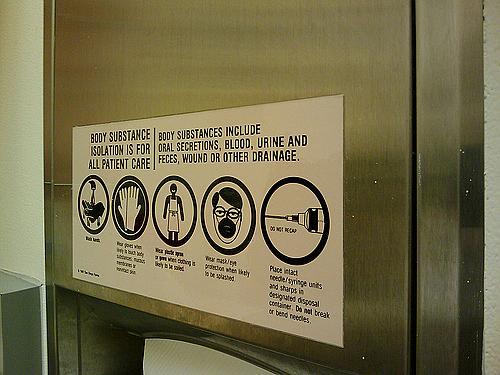Herd Immunity: Veterans Affairs beating MRSA with simple weapons

The rates of infection with the MRSA superbug are so low in the Louisville Veterans Affairs Medical Center that they are a little hard to fathom.
Out of every 1,000 bed days of care, the hospital now has 0.09 infections. That’s down dramatically from 2008 when the rate was 1.89 infections per 1,000 bed days. That’s a 95% reduction.
You might ask, “How can a hospital have 0.09 infections?” Well, it can’t, but that’s how the official math works out because the number of infections is so low. A better way to put it would be for every 10,000 bed days, there is about 1 infection.
What did the hospital do? Invest millions in new technology?
No. The hospital just started checking patients for MRSA and taking care to make sure that staff kept their hands and clothes clean. It’s part of a system-wide program started by Veterans Affairs in 2007 and fully implemented across VA hospitals and long-term care centers over the past few years. Two earlier studies have shown strong results, too.
In 2011, Kevin Sack at The New York Times reported:
The study of 153 Veterans Affairs hospitals nationwide found a 62 percent drop in the rate of infections caused by methicillin-resistant Staphylococcus aureus, or MRSA, in intensive care units over a 32-month period. There was a 45 percent drop in MRSA prevalence in other hospital wards, like surgical and rehabilitation units. The Veterans Affairs strategy employs a “bundle” of measures that include screening all patients with nasal swabs, isolating those who test positive for MRSA, requiring that staff treating those patients wear gloves and gowns and take other contact precautions and encouraging rigorous hand washing.
This January, Robert Preidt at HealthDay wrote:
The number of infections with dangerous antibiotic-resistant bacteria at VA long-term care centers has dropped since a program to combat the problem was launched in 2009, a new report shows. The initiative to reduce the number of methicillin-resistant Staphylococcus aureus (MRSA) infections was implemented in 133 VA long-term care facilities. Within 42 months, there was a 36 percent decrease in MRSA infections at those centers.
But now the bad news.
One would think that hospitals everywhere would be looking at these VA results and saying, “How do I get in on this?” But even where the results are stunning – in Kentucky – hospitals are not choosing to replicate the success. As Laura Ungar at the Louisville Courier-Journal described it:
Officials at Louisville hospitals outside the VA said they don't screen every admitted patient — partly because of the cost, which is about $55 per screening, and partly because they consider other infection-control methods at least as effective. Norton Healthcare, for instance, stresses washing hands, isolating patients with MRSA, and wearing gowns and gloves while caring for them.
"In general, we have not done surveillance screening. It's somewhat of a controversial topic," said Dr. Paul Schulz, an infectious disease specialist with Norton. "We do all we can do that makes the most sense."
Ungar goes on to describe what is perhaps the biggest barrier to broader use of the VA bundle: lack of reporting. If you don’t know what the trends are in infections, how can you benchmark your organization and get better? As Ungar wrote:
It's difficult to compare the success of universal screening to other infection-control strategies, since most hospitals don't release MRSA rates. The state only requires hospitals to report outbreaks and has no standard definition of what that means. Hospital officials said they do report what they believe are outbreaks — beyond the normal number of cases — and no MRSA outbreaks in hospitals were reported to the state last year.
This goes back to the project that I proposed at the beginning of these Herd Immunity posts. Let’s raise our collective voices to encourage more detailed reporting of infections. As I said in March 2012:
In Montana, my home state, there are more cows than people - and not by a small margin. At 2.6 million head of cattle and 998,000 people, that's nearly three head of cattle per person. State and federal agricultural agencies can tell you with precision about the location and status of these animals. They know about their health and their potential for generating economic wealth. They create maps that show precisely how many cows there are in every county in the United States. And yet no state or federal health agency can provide you a similar level of detail about a different animal that poses a serious health threat to people: methicillin resistant Staphylococcus aureus (MRSA). … It bears repeating: why should people in Montana know more about their cows than their healthcare-acquired infections?
Image by moppet65535 via Flickr

